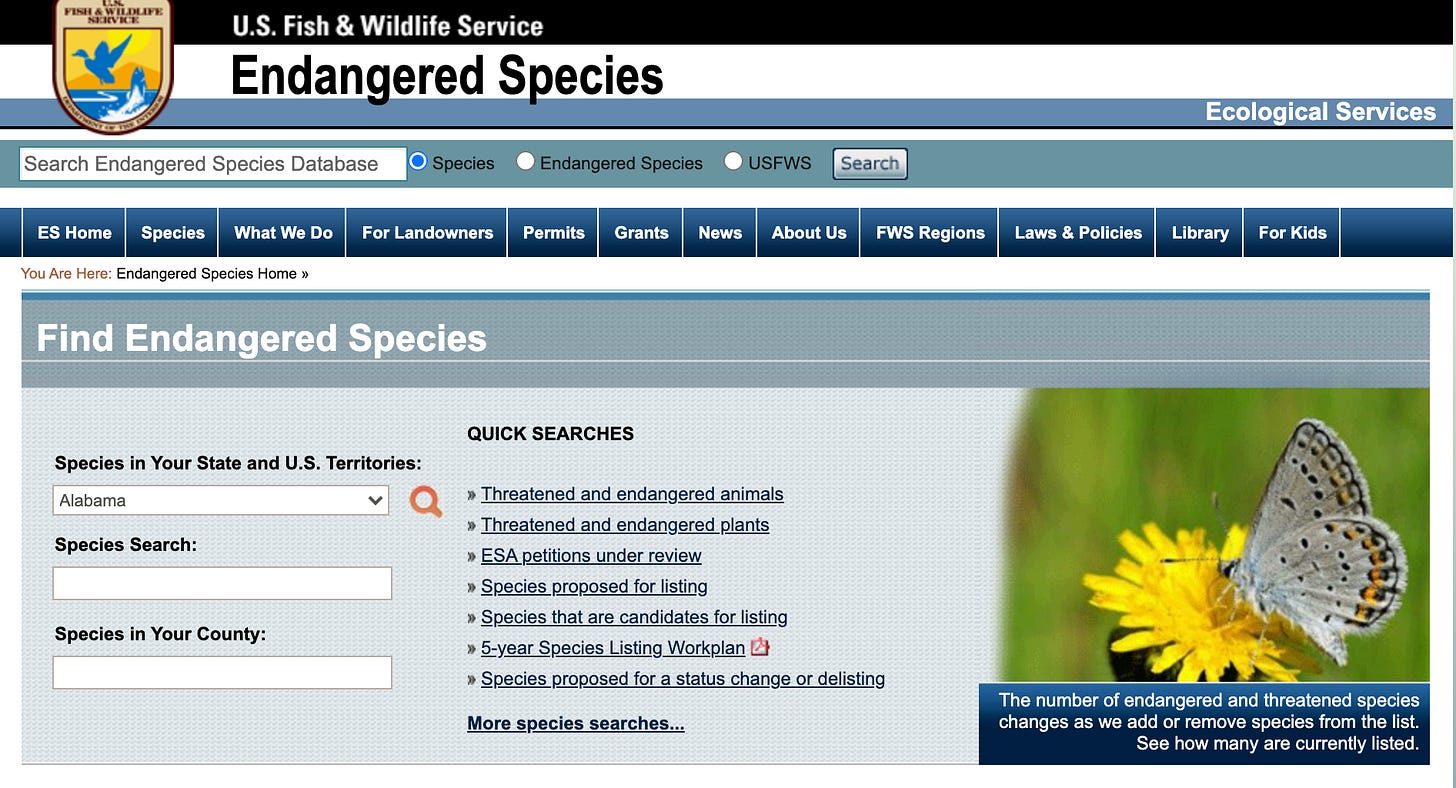Which Endangered Species Are in Your Backyard?
Lawsuits for the EPA and a useful tool from the U.S. Fish & Wildlife Service
In Civics this Week: Pesticide Policies and Endangered Species
This week, the United States Environmental Protection Agency (EPA) announced a new practice of evaluating the effects of new pesticide active ingredients (AIs) on species and habitats protected under the Endangered Species Act (ESA) before registering them. If they determine that an AI will have negative impacts, the new policy will require the EPA to consult the U.S. Fish and Wildlife Services (FWS) and the National Marine Fisheries Service before registering the ingredient.
Over the years, several litigations have claimed that the EPA has failed to comply with the ESA.1 Just four days before this new policy announcement, the Center for Biological Diversity filed an intent to sue the EPA for approving 300 pyrethroid insecticide products that harm many endangered species. While this new policy brings hope of renewed commitment to compliance, the Center of Biological Diversity expressed in a press release that they are concerned the FWS will struggle to respond to the new policy and address consultation requests promptly.2
Keeping up on endangered species communities isn’t just important for EPA and FWS officials - we can all benefit from learning more about our local ecosystems. That way, we are better equipped to advocate for their protection from harmful policies.
Let’s give it a shot!
Which Endangered Species Are in Your Backyard?
There is a lot more information you can find out about endangered species in your local area than you might think. The FWS maintains an Endangered Species database where you can search by state, species, and county. You can also search by several species reports. To supplement these findings, there is a “Success Stories” tool that you can use to obtain a state profile on endangered/threatened species and protective efforts.
Let’s try an example! If we’re attempting to search for what might be in (or near) our backyards, we’ll do a county search using York County, Maine, home to some of my family. You can use any of the three search bars pictured above independently (i.e. you do not have to select the state and then the county, you can just search for the county and select the correct choice).
Once you search for your county, you will be directed to the respective Species County Report that lists species in the county and their status. Clicking on any of the names will take you to a profile of that species with further details.
I’m intrigued by the Leatherback sea turtle, so I’m going to pull up that profile and take a closer look. Underneath the species name, there are hyperlinks to the main sections of this profile. Its endangered status is highlighted in red along with some general information, which is worth reading - I had no idea that these turtles could get up to 2000 pounds!
Scrolling down, there are a few more sections that may be of interest. The Range Information provides an interactive map of the locations where the sea turtle is known or believed to occur.
Lastly, you can delve further to find numerous types of documents related to the species, including those published in the Federal Register (see my first newsletter to learn more about this government publication!), Species Status Assessments (SSAs), recovery plans, critical habitat determinations, conservation plans, petitions, biological opinions from FWS, and life history information. Not all species have every section filled out. The sea turtles, for example, are missing SSAs and life history information.
Some of the documents listed in this index can provide specific, interesting windows into history. For example, one of the Federal Register documents on the sea turtles concerns regulations introduced in 1987 identifying shrimp trawling as a leading cause of turtle mortality and consequently requiring shrimp trawlers to use “turtle excluder devices” or “TEDs” to avoid accidentally trapping the creatures.3
Diagram of a TED4
Reading section f., “Comments on the Proposed Regulation…” reveals concerns expressed in public hearings (which were held in each state impacted by the regulation) or letters from people who opposed this regulation, stating objections ranging from ineffectiveness to higher insurance rates to dangerous equipment to the potential devastation of local shrimp trawling economies.5 It was quite the controversy! A quick Google search revealed a section on the site for NOAA Fisheries that covers the evolution of TED design and implementation as well as shrimp import legislation. An interesting read, if you have the time to peruse it.
In Conclusion
Without a doubt, the FWS database for Endangered Species can lead you down a rabbit hole. This being said, this research will sensitize you to historical or current issues regarding endangered species in your community. Perhaps you will find yourself inspired to attend the next public hearing in your county on this topic!
Have you discovered any species in your area that you didn’t realize were endangered? Any intriguing histories that you uncover? Let me know in the comments!
See you next week.
To research this further, one place to start is news releases from the Center for Biological Diversity, as they monitor these lawsuits closely.
See coverage on this topic from The Hill. See also this overview of ESA implementation on fws.gov.
52 Fed. Reg. 24244 (June 28, 1987).
52 Fed. Reg. 24258 (June 28, 1987).
52 Fed. Reg. 24245 (June 28, 1987).







